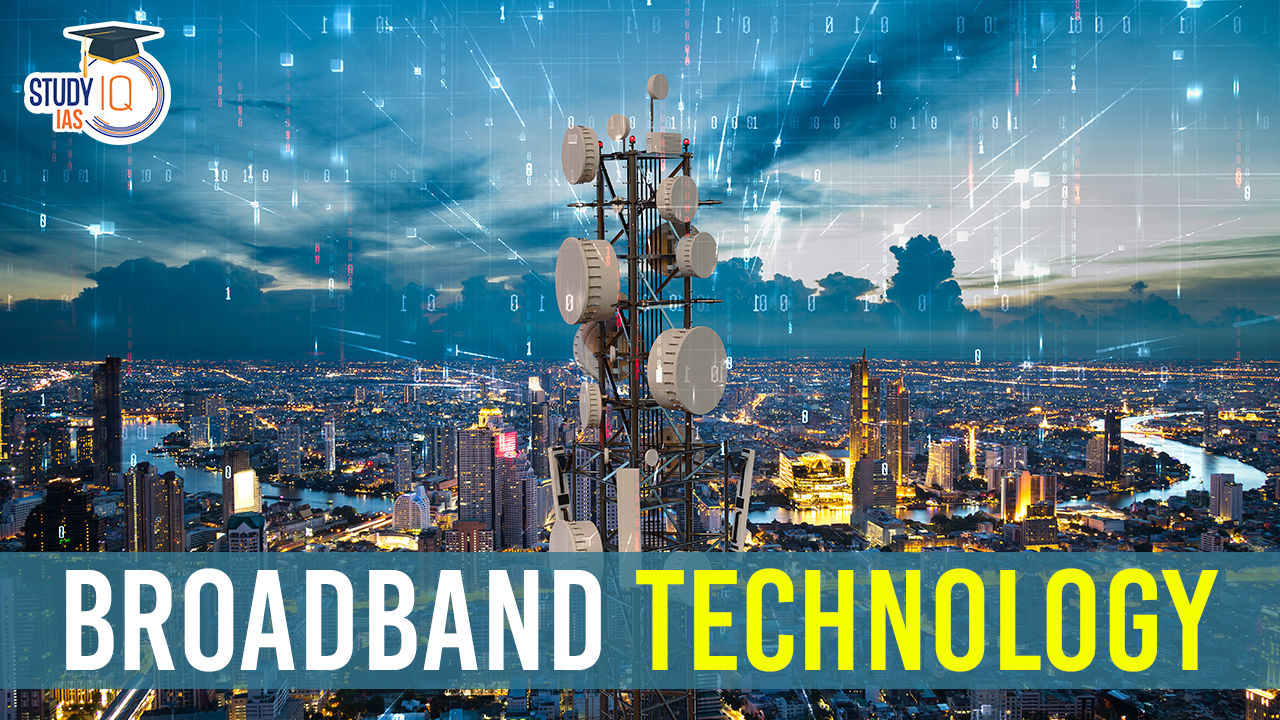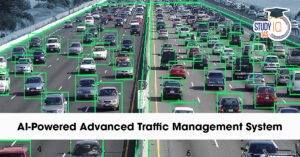Table of Contents
Broadband refers to a high-speed internet connection that enables rapid data transfer to a variety of web-enabled devices, such as personal computers, laptops, tablets, smartphones, and smart TVs. Its name derives from the extensive range of frequencies it utilizes for transmitting information.
What is Broadband Technology?
Broadband technology is a set of communication techniques that utilize a wide range or “band” of frequencies to transmit data at high speeds over various communication networks. It enables the rapid transfer of digital information, including internet data, audio, video, and more, to end-user devices. Broadband technology encompasses several methods and technologies, including:
- Digital Subscriber Line (DSL): DSL uses existing telephone lines to transmit data. It allows for simultaneous voice and high-speed data transmission over the same line.
- Cable Modem: This technology uses cable television infrastructure to deliver high-speed internet access. It provides a more extensive bandwidth than DSL.
- Fiber Optic Broadband: Fiber optic cables use light signals to transmit data, offering extremely high speeds and reliability. It’s known for its ability to transmit data over long distances with minimal signal loss.
- Coaxial Cable: Similar to cable modems, coaxial cables can provide high-speed internet access, especially in areas where cable television is prevalent.
- 4G and 5G Mobile Communication: These wireless technologies provide broadband-level data speeds for mobile devices and are commonly used for mobile internet access.
- Satellite Internet: Satellite broadband involves the use of geostationary satellites to transmit data to and from user equipment via a satellite dish. It is often used in remote or rural areas with limited wired infrastructure.
- Wi-Fi: While Wi-Fi itself is a wireless technology, it plays a significant role in distributing broadband connections within homes, businesses, and public spaces.
Broadband technology is essential for modern communication, enabling the fast and efficient transfer of data for various applications, including web browsing, video streaming, online gaming, and business communication. It has revolutionized the way people connect and interact in today’s digital age.
We’re now on WhatsApp. Click to Join
Broadband Technology in India
Broadband technology in India encompasses both wired and wireless internet access solutions, with the following usage statistics:
Wired Technologies: Fibre optics (34.84%), DSL (23.77%), Ethernet/LAN (28.57%).
Wireless Technologies: LTE (91.26%), GPRS/EDGE (5.50%).
Broadband, a high-capacity transmission technology, facilitates the swift transfer of data, voice, and video across extensive distances at rapid speeds. Common transmission mediums include coaxial cables, fiber optic cables, and radio waves.
India’s broadband sector is still in its early stages, featuring approximately 150 million subscribers, resulting in a penetration rate of about 12%. Nevertheless, the number of mobile broadband subscribers has surged by 2.5 times in the past two years.
India has adopted a new definition of broadband, classifying it as “a data connection that supports interactive services, including internet access, with a minimum download speed of 2 Mbps per individual subscriber.”
Fiber internet stands as the fastest internet option available for traditional residential and commercial customers in India. It harnesses fiber-optic cables to transmit data using light pulses, offering gigabit speeds for both residential and commercial users.
Key internet service providers in India include Jio, Airtel, Vi, and BSNL. These companies play a significant role in delivering broadband services to consumers and businesses across the country.
| Year | Milestones in Broadband Technology Development in India |
| Early 2000s | Introduction of DSL and cable broadband services, primarily in urban areas. |
| 2005 | Launch of the National Broadband Policy to promote widespread broadband services. |
| 2007 | BSNL’s role in expanding broadband access, particularly in rural areas, with affordable plans. |
| 2010 | Private broadband providers like Airtel, Tata, and Reliance expanding networks in urban and semi-urban regions. |
| 2011 | Introduction of 3G and 4G mobile services, a significant step towards mobile broadband. |
| 2015 | “Digital India” initiative aimed at increasing broadband adoption, especially in rural areas, and promoting digital literacy. |
| 2016 | Disruption of the telecom market with the launch of Reliance Jio, offering high-speed 4G services at affordable rates. |
| 2018 | Ongoing evolution of India’s broadband landscape with the rollout of 4G networks, increasing accessibility. |
| 2020 | COVID-19 pandemic emphasizes the importance of broadband for remote work, education, and healthcare, highlighting the need for improved access and reliability. |
| Present | Ongoing expansion of broadband infrastructure, including the BharatNet project connecting rural areas and private telecom investments in 5G technology. |
Future of Broadband Technology
The future of broadband technology is poised to bring about faster, more accessible, and cost-effective advancements. Anticipated developments in broadband networks encompass:
- Accelerated Speeds: Broadband networks will offer even faster data transfer rates, enhancing user experiences for various applications.
- Expanded Bandwidth: Higher bandwidths will allow for more data-intensive activities, such as 4K streaming, augmented reality, and virtual reality.
- Reduced Latency: Lower latency will enable real-time, interactive experiences for gaming, video conferencing, and other applications.
- Enhanced Capacity and Reliability: Networks will exhibit improved capacity and reliability, ensuring consistent connectivity even during peak usage times.
- Wider Broadband Accessibility: The reach of broadband services will expand, connecting more remote and underserved regions.
- Fiber Deployment Expansion: The deployment of fiber-optic networks will proliferate, providing high-speed connections to a broader audience.
- Enhanced Cloud-Native Network Management: Increasing intelligence in cloud-native network management software will optimize network performance and efficiency.
Technologies driving the future of broadband encompass:
- 10G: The emergence of 10G technology will usher in even higher speeds and capacities for broadband networks.
- Cloud Integration: Cloud-based solutions will play a pivotal role in delivering services and storing data efficiently.
- Virtualization: Network virtualization will enable flexible and scalable network configurations to meet evolving demands.
- Software Defined Networking (SDN)-Based Automation: SDN-driven automation will enhance network control and management.
- Open Source: The use of open-source solutions will foster innovation and cost-effectiveness in broadband infrastructure.
- Network Function Virtualization (NFV): NFV will provide a more agile and adaptable network architecture.
- DOCSIS and DAA: Technologies like DOCSIS (Data Over Cable Service Interface Specification) and DAA (Distributed Access Architecture) will improve cable broadband services.
As 5G networks become increasingly prevalent, fixed-line broadband providers will face heightened demand for higher speeds and more reliable connectivity, as they strive to meet the evolving needs of users. The future of broadband promises to be dynamic, responsive, and capable of supporting the growing digital landscape.
Advantages of Broadband Technology
Broadband technology offers several advantages, which include:
- Speed: Broadband connections are significantly faster than dial-up, making them ideal for users who frequently download or upload large files.
- Connectivity: Broadband allows multiple users to be online simultaneously, supporting multiple devices and users within a household or business.
- Reliability: Broadband offers a reliable internet connection, reducing the likelihood of disconnections or dropped calls.
- Quality: Wireless broadband services can provide improved video and audio quality for streaming and communication applications.
- Access: Broadband enhances access to essential services like education, healthcare, and government resources, particularly in remote or underserved areas.
- Telework: Broadband enables telecommuting, allowing individuals to live and work in locations of their choice, increasing work flexibility.
- Signal Interference: Broadband connections are less susceptible to signal interference, providing more stable and consistent connectivity compared to Wi-Fi.
- No Need for a Telephone Line: Broadband doesn’t require a dedicated telephone line for internet access, freeing up the phone line for voice calls.
- Internet Connection Stays Active: Unlike dial-up, broadband connections do not tie up the phone line, ensuring continuous internet availability.
- Cost-Effective: Over time, broadband can be cost-effective, as it eliminates the need for a dedicated phone line and offers better value for high-speed internet access.
Broadband technology has become a fundamental part of modern life, enabling faster, more reliable, and versatile internet connections that cater to various user needs, whether for work, entertainment, or communication.
Challenges of Broadband Technology in India
- Affordability: Many rural households find internet plans expensive, and even a basic 250 MB data plan may be beyond their means.
- Slow Internet Speed: Internet speed in India is often sluggish due to infrastructure limitations, government inaction, and a heavy reliance on private telecom companies.
- Delays in Issue Resolution: Approximately 46% of users reported extended wait times, with service providers taking more than 24 hours to address their complaints.
- Underpenetration of Broadband: India faces the challenge of low broadband penetration, hindering widespread access to high-speed internet services.
Broadband Technology UPSC
Broadband technology, a high-speed internet connection, utilizes various methods, including DSL, cable, fiber optics, and mobile communication, to transmit data rapidly to devices. In India, broadband adoption is growing, with both wired (fiber, DSL) and wireless (LTE) technologies gaining popularity. The future of broadband promises faster speeds, expanded bandwidth, lower latency, and wider accessibility, driven by technologies like 10G, cloud integration, and network virtualization. Despite its advantages, challenges in India include affordability issues, slow internet speeds, delays in issue resolution, and low broadband penetration. Nevertheless, ongoing infrastructure expansion and investments aim to address these challenges and promote widespread access to high-speed internet.


 Mental Healthcare in India, Scope and Go...
Mental Healthcare in India, Scope and Go...
 Most Commonly Used Cancer Drugs and Thei...
Most Commonly Used Cancer Drugs and Thei...
 India Launched AI-Powered Traffic Manage...
India Launched AI-Powered Traffic Manage...





















